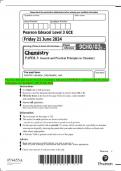Exam (elaborations)
Pearson Edexcel Level 3 GCE Chemistry Advanced PAPER 3: General and Practical Principles in Chemistry QP JUNE 2024
Course
Pearson Edexcel Level 3 GCE Chemistry
Institution
Pearson Edexcel Level 3 GCE Chemistry
Pearson Edexcel Level 3 GCE Chemistry Advanced PAPER 3: General and Practical
Principles in Chemistry QP JUNE 2024
[Show more]
Preview 4 out of 32 pages
Uploaded on
September 30, 2024
Number of pages
32
Written in
2024/2025
Type
Exam (elaborations)
Contains
Questions & answers
Institution
Pearson Edexcel Level 3 GCE Chemistry
Course
Pearson Edexcel Level 3 GCE Chemistry
$12.99
100% satisfaction guarantee
Immediately available after payment
Both online and in PDF
No strings attached
surname names




